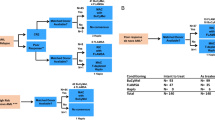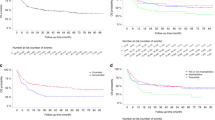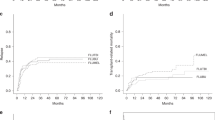Abstract
AML is currently the first indication for allogeneic hematopoietic stem cell transplantation (allo-HSCT), as shown by international transplant registries. The conditioning regimens are classified as myeloablative conditioning, non-myeloablative or reduced intensity conditioning. Targeted radioimmunotherapy such as anti-CD45 antibody have also been added to the conditioning regimen in an attempt to improve tumor cell kill. Refinement of standard regimens has led to a reduction of non-relapse mortality, also in the older age group over 60 or 70 years of age. Relapse post allo-HSCT remains an important issue, especially for patients who undergo transplant with residual or refractory disease. In these patients, pre- and post-transplant interventions need to be considered.
This is a preview of subscription content, access via your institution
Access options
Subscribe to this journal
Receive 12 print issues and online access
$259.00 per year
only $21.58 per issue
Buy this article
- Purchase on Springer Link
- Instant access to full article PDF
Prices may be subject to local taxes which are calculated during checkout

Similar content being viewed by others
References
Peccatori J, Ciceri F . Allogeneic stem cell transplantation for acute myeloid leukemia. Haematologica 2010; 95: 857–859.
Ossenkoppele G, Lowenberg B . How I treat the older patient with acute myeloid leukemia. Blood 2015; 125: 767–774.
Arcese W, Mangione I, Picardi A . Algorithm for donor selection in 2011. Curr Opin Hematol 2011; 18: 401–407.
Bacigalupo A, Ballen K, Rizzo D, Giralt S, Lazarus H, Ho V et al. Defining the intensity of conditioning regimens: working definitions. Biol Blood Marrow Transplant 2009; 15: 1628–1633.
Clift RA, Buckner CD, Thomas ED, Bensinger WI, Bowden R, Bryant E et al. Marrow transplantation for chronic myeloid leukemia: a randomized study comparing cyclophosphamide and total body irradiation with busulfan and cyclophosphamide. Blood 1994; 84: 2036–2043.
Holter-Chakrabarty JL, Pierson N, Zhang MJ, Zhu X, Akpek G, Aljurf MD et al. The sequence of cyclophosphamide and myeloablative total body irradiation in hematopoietic cell transplantation for patients with acute leukemia. Biol Blood Marrow Transplant 2015; 21: 1251–1257.
Giebel S, Miszczyk L, Slosarek K, Moukhtari L, Ciceri F, Esteve J et al. Extreme heterogeneity of myeloablative total body irradiation techniques in clinical practice: a survey of the Acute Leukemia Working Party of the European Group for Blood and Marrow Transplantation. Cancer 2014; 120: 2760–2765.
Wong JY, Forman S, Somlo G, Rosenthal J, Liu A, Schultheiss T et al. Dose escalation of total marrow irradiation with concurrent chemotherapy in patients with advanced acute leukemia undergoing allogeneic hematopoietic cell transplantation. Int. J Radiat Oncol Biol Phys 2013; 85: 148–156.
Wong JY, Liu A, Schultheiss T, Popplewell L, Stein A, Rosenthal J et al. Targeted total marrow irradiation using three-dimensional image-guided tomographic intensity-modulated radiation therapy: an alternative to standard total body irradiation. Biol Blood Marrow Transplant 2006; 12: 306–315.
Schmid C, Schleuning M, Ledderose G, Tischer J, Kolb HJ . Sequential regimen of chemotherapy, reduced-intensity conditioning for allogeneic stem-cell transplantation, and prophylactic donor lymphocyte transfusion in high-risk acute myeloid leukemia and myelodysplastic syndrome. J Clin Oncol 2005; 23: 5675–5687.
Schmid C, Schleuning M, Schwerdtfeger R, Hertenstein B, Mischak-Weissinger E, Bunjes D et al. Long-term survival in refractory acute myeloid leukemia after sequential treatment with chemotherapy and reduced-intensity conditioning for allogeneic stem cell transplantation. Blood 2006; 108: 1092–1099.
Gesine Bug AB, Nicolaus Kroeger, Huenecke Sabine, Duenzinger Ulrich, Wolf Andrea, Bader Peter et al. Phase I/II study of the deacetylase inhibitor Panobinostat as maintenance therapy after an allogeneic stem cell transplantation in patients with high-risk MDS or AML: The Panobest-Trial. Abstract retrieved from ASH 2015 2015. Blood 2015; 126: 4344.
Morris ES, MacDonald KP, Kuns RD, Morris HM, Banovic T, Don AL et al. Induction of natural killer T cell-dependent alloreactivity by administration of granulocyte colony-stimulating factor after bone marrow transplantation. Nat Med 2009; 15: 436–441.
Nath CE, Shaw PJ . Busulphan in blood and marrow transplantation: dose, route, frequency and role of therapeutic drug monitoring. Curr Clin Pharmacol 2007; 2: 75–91.
Bredeson C, LeRademacher J, Kato K, Dipersio JF, Agura E, Devine SM et al. Prospective cohort study comparing intravenous busulfan to total body irradiation in hematopoietic cell transplantation. Blood 2013; 122: 3871–3878.
Socie G, Clift RA, Blaise D, Devergie A, Ringden O, Martin PJ et al. Busulfan plus cyclophosphamide compared with total-body irradiation plus cyclophosphamide before marrow transplantation for myeloid leukemia: long-term follow-up of 4 randomized studies. Blood 2001; 98: 3569–3574.
Nagler A, Rocha V, Labopin M, Unal A, Ben Othman T, Campos A et al. Allogeneic hematopoietic stem-cell transplantation for acute myeloid leukemia in remission: comparison of intravenous busulfan plus cyclophosphamide (Cy) vs total-body irradiation plus Cy as conditioning regimen—a report from the acute leukemia working party of the European group for blood and marrow transplantation. J Clin Oncol 2013; 31: 3549–3556.
Litzow MR, Perez WS, Klein JP, Bolwell BJ, Camitta B, Copelan EA et al. Comparison of outcome following allogeneic bone marrow transplantation with cyclophosphamide-total body irradiation versus busulphan-cyclophosphamide conditioning regimens for acute myelogenous leukaemia in first remission. Br J Haematol 2002; 119: 1115–1124.
Chao NJ, Stein AS, Long GD, Negrin RS, Amylon MD, Wong RM et al. Busulfan/etoposide—initial experience with a new preparatory regimen for autologous bone marrow transplantation in patients with acute nonlymphoblastic leukemia. Blood 1993; 81: 319–323.
Linker CA, Ries CA, Damon LE, Rugo HS, Wolf JL . Autologous bone marrow transplantation for acute myeloid leukemia using busulfan plus etoposide as a preparative regimen. Blood 1993; 81: 311–318.
Linker C . The role of autologous transplantation for acute myeloid leukemia in first and second remission. Best Pract Res Clin Haematol 2007; 20: 77–84.
Gondo H, Harada M, Miyamoto T, Takenaka K, Tanimoto K, Mizuno S et al. Autologous peripheral blood stem cell transplantation for acute myelogenous leukemia. Bone Marrow Transplant 1997; 20: 821–826.
Lee JH, Joo YD, Kim H, Ryoo HM, Kim MK, Lee GW et al. Randomized trial of myeloablative conditioning regimens: busulfan plus cyclophosphamide vs busulfan plus fludarabine. J Clin Oncol 2013; 31: 701–709.
Gyurkocza B, Storb R, Storer BE, Chauncey TR, Lange T, Shizuru JA et al. Nonmyeloablative allogeneic hematopoietic cell transplantation in patients with acute myeloid leukemia. J Clin Oncol 2010; 28: 2859–2867.
Hegenbart U, Niederwieser D, Sandmaier BM, Maris MB, Shizuru JA, Greinix H et al. Treatment for acute myelogenous leukemia by low-dose, total-body, irradiation-based conditioning and hematopoietic cell transplantation from related and unrelated donors. J Clin Oncol 2006; 24: 444–453.
Blum W, Brown R, Lin HS, Zehnbauer B, Khoury H, Goodnough LT et al. Low-dose (550cGy), single-exposure total body irradiation and cyclophosphamide: consistent, durable engraftment of related-donor peripheral blood stem cells with low treatment-related mortality and fatal organ toxicity. Biol Blood Marrow Transplant 2002; 8: 608–618.
Slavin S, Nagler A, Naparstek E, Kapelushnik Y, Aker M, Cividalli G et al. Nonmyeloablative stem cell transplantation and cell therapy as an alternative to conventional bone marrow transplantation with lethal cytoreduction for the treatment of malignant and nonmalignant hematologic diseases. Blood 1998; 91: 756–763.
Rambaldi A, Grassi A, Masciulli A, Boschini C, Mico MC, Busca A et al. Busulfan plus cyclophosphamide versus busulfan plus fludarabine as a preparative regimen for allogeneic haemopoietic stem-cell transplantation in patients with acute myeloid leukaemia: an open-label, multicentre, randomised, phase 3 trial. Lancet Oncol 2015; 16: 1525–1536.
Giralt S . Busulfan-based conditioning regimens: not all partners are equal. Lancet Oncol 2015; 16: 1448–1449.
Michallet M, Sobh M, Milpied N, Bay JO, Furst S, Harousseau JL et al. Phase II prospective study of treosulfan-based reduced-intensity conditioning in allogeneic HSCT for hematological malignancies from 10/10 HLA-identical unrelated donor. Ann Hematol 2012; 91: 1289–1297.
Kroger N, Shimoni A, Zabelina T, Schieder H, Panse J, Ayuk F et al. Reduced-toxicity conditioning with treosulfan, fludarabine and ATG as preparative regimen for allogeneic stem cell transplantation (alloSCT) in elderly patients with secondary acute myeloid leukemia (sAML) or myelodysplastic syndrome (MDS). Bone Marrow Transplant 2006; 37: 339–344.
Shimoni A, Hardan I, Shem-Tov N, Rand A, Yerushalmi R, Nagler A . Fludarabine and treosulfan: a novel modified myeloablative regimen for allogeneic hematopoietic stem-cell transplantation with effective antileukemia activity in patients with acute myeloid leukemia and myelodysplastic syndromes. Leuk Lymphoma 2007; 48: 2352–2359.
Gyurkocza B, Gutman J, Nemecek ER, Bar M, Milano F, Ramakrishnan A et al. Treosulfan, fludarabine, and 2-Gy total body irradiation followed by allogeneic hematopoietic cell transplantation in patients with myelodysplastic syndrome and acute myeloid leukemia. Biol Blood Marrow Transplant 2014; 20: 549–555.
Chevallier P, Labopin M, Buchholz S, Ganser A, Ciceri F, Lioure B et al. Clofarabine-containing conditioning regimen for allo-SCT in AML/ALL patients: a survey from the Acute Leukemia Working Party of EBMT. Eur J Haematol 2012; 89: 214–219.
Scott BL, Pasquini MC, Logan B, Wu J, Devine S, Porter D et al Results of a phase III randomized, multicenter study of allogeneic stem cell transplantation after high versus reduced intensity conditioning in patients with myelodysplastic syndrome or acute myeloid leukemia. Blood and Marrow Transplant Clinical Trials Network 0901. 2015 ASH Annual Meeting. Abstract LBA-8. Presented 8 December 2015.
Bornhauser M, Kienast J, Trenschel R, Burchert A, Hegenbart U, Stadler M et al. Reduced-intensity conditioning versus standard conditioning before allogeneic haemopoietic cell transplantation in patients with acute myeloid leukaemia in first complete remission: a prospective, open-label randomised phase 3 trial. Lancet Oncol 2012; 13: 1035–1044.
Zeng W, Huang L, Meng F, Liu Z, Zhou J, Sun H . Reduced-intensity and myeloablative conditioning allogeneic hematopoietic stem cell transplantation in patients with acute myeloid leukemia and myelodysplastic syndrome: a meta-analysis and systematic review. Int J Clin Exp Med 2014; 7: 4357–4368.
Ringden O, Brazauskas R, Wang Z, Ahmed I, Atsuta Y, Buchbinder D et al. Second solid cancers after allogeneic hematopoietic cell transplantation using reduced-intensity conditioning. Biol Blood Marrow Transplant 2014; 20: 1777–1784.
Shimoni A . Second malignancies after allogeneic stem cell transplantation with reduced-intensity conditioning: is the incidence reduced? Biol Blood Marrow Transplant 2014; 20: 1669–1670.
Shimoni A, Shem-Tov N, Chetrit A, Volchek Y, Tallis E, Avigdor A et al. Secondary malignancies after allogeneic stem-cell transplantation in the era of reduced-intensity conditioning; the incidence is not reduced. Leukemia 2013; 27: 829–835.
Rovo A, Tichelli A, Passweg JR, Heim D, Meyer-Monard S, Holzgreve W et al. Spermatogenesis in long-term survivors after allogeneic hematopoietic stem cell transplantation is associated with age, time interval since transplantation, and apparently absence of chronic GvHD. Blood 2006; 108: 1100–1105.
Savani BN, Kozanas E, Shenoy A, Barrett AJ . Recovery of spermatogenesis after total-body irradiation. Blood 2006; 108: 4292–4293.
Aversa F, Tabilio A, Terenzi A, Velardi A, Falzetti F, Giannoni C et al. Successful engraftment of T-cell-depleted haploidentical ‘three-loci’ incompatible transplants in leukemia patients by addition of recombinant human granulocyte colony-stimulating factor-mobilized peripheral blood progenitor cells to bone marrow inoculum. Blood 1994; 84: 3948–3955.
Lu DP, Dong L, Wu T, Huang XJ, Zhang MJ, Han W et al. Conditioning including antithymocyte globulin followed by unmanipulated HLA-mismatched/haploidentical blood and marrow transplantation can achieve comparable outcomes with HLA-identical sibling transplantation. Blood 2006; 107: 3065–3073.
Raiola A, Dominietto A, Varaldo R, Ghiso A, Galaverna F, Bramanti S et al. Unmanipulated haploidentical BMT following non-myeloablative conditioning and post-transplantation CY for advanced Hodgkin's lymphoma. Bone Marrow Transplant 2014; 49: 190–194.
Raiola AM, Dominietto A, Ghiso A, Di Grazia C, Lamparelli T, Gualandi F et al. Unmanipulated haploidentical bone marrow transplantation and posttransplantation cyclophosphamide for hematologic malignancies after myeloablative conditioning. Biol Blood Marrow Transplant 2013; 19: 117–122.
Solomon SR, Sizemore CA, Sanacore M, Zhang X, Brown S, Holland HK et al. Haploidentical transplantation using T cell replete peripheral blood stem cells and myeloablative conditioning in patients with high-risk hematologic malignancies who lack conventional donors is well tolerated and produces excellent relapse-free survival: results of a prospective phase II trial. Biol Blood Marrow Transplant 2012; 18: 1859–1866.
Solomon SR, Sizemore CA, Sanacore M, Zhang X, Brown S, Holland HK et al. Total body irradiation-based myeloablative haploidentical stem cell transplantation is a safe and effective alternative to unrelated donor transplantation in patients without matched sibling donors. Biol Blood Marrow Transplant 2015; 21: 1299–1307.
Kanakry JA, Kasamon YL, Gocke CD, Tsai HL, Davis-Sproul J, Ghosh N et al. Outcomes of related donor HLA-identical or HLA-haploidentical allogeneic blood or marrow transplantation for peripheral T cell lymphoma. Biol Blood Marrow Transplant 2013; 19: 602–606.
Di Stasi A, Milton DR, Poon LM, Hamdi A, Rondon G, Chen J et al. Similar transplantation outcomes for acute myeloid leukemia and myelodysplastic syndrome patients with haploidentical versus 10/10 human leukocyte antigen-matched unrelated and related donors. Biol Blood Marrow Transplant 2014; 20: 1975–1981.
Brammer JE, Khouri I, Gaballa S, Anderlini P, Tomuleasa C, Ahmed S et al. Outcomes of haploidentical stem cell transplantation for lymphoma with melphalan-based conditioning. Biol Blood Marrow Transplant 2016; 22: 493–498.
Wang Y, Liu QF, Xu LP, Liu KY, Zhang XH, Ma X et al. Haploidentical vs identical-sibling transplant for AML in remission: a multicenter, prospective study. Blood 2015; 125: 3956–3962.
Barker JN, Weisdorf DJ, DeFor TE, Blazar BR, McGlave PB, Miller JS et al. Transplantation of 2 partially HLA-matched umbilical cord blood units to enhance engraftment in adults with hematologic malignancy. Blood 2005; 105: 1343–1347.
Ponce DM, Sauter C, Devlin S, Lubin M, Gonzales AM, Kernan NA et al. A novel reduced-intensity conditioning regimen induces a high incidence of sustained donor-derived neutrophil and platelet engraftment after double-unit cord blood transplantation. Biol Blood Marrow Transplant 2013; 19: 799–803.
Cutler C, Stevenson K, Kim HT, Brown J, McDonough S, Herrera M et al. Double umbilical cord blood transplantation with reduced intensity conditioning and sirolimus-based GVHD prophylaxis. Bone Marrow Transplant 2011; 46: 659–667.
Pagel JM, Appelbaum FR, Eary JF, Rajendran J, Fisher DR, Gooley T et al. 131I-anti-CD45 antibody plus busulfan and cyclophosphamide before allogeneic hematopoietic cell transplantation for treatment of acute myeloid leukemia in first remission. Blood 2006; 107: 2184–2191.
Pagel JM, Gooley TA, Rajendran J, Fisher DR, Wilson WA, Sandmaier BM et al. Allogeneic hematopoietic cell transplantation after conditioning with 131I-anti-CD45 antibody plus fludarabine and low-dose total body irradiation for elderly patients with advanced acute myeloid leukemia or high-risk myelodysplastic syndrome. Blood 2009; 114: 5444–5453.
Thomas ED, Clift RA, Hersman J, Sanders JE, Stewart P, Buckner CD et al. Marrow transplantation for acute nonlymphoblastic leukemic in first remission using fractionated or single-dose irradiation. Int J Radiat Oncol Biol Phys 1982; 8: 817–821.
Petersen FB, Deeg HJ, Buckner CD, Appelbaum FR, Storb R, Clift RA et al. Marrow transplantation following escalating doses of fractionated total body irradiation and cyclophosphamide—a phase I trial. Int J Radiat Oncol Biol Phys 1992; 23: 1027–1032.
Demirer T, Petersen FB, Appelbaum FR, Barnett TA, Sanders J, Deeg HJ et al. Allogeneic marrow transplantation following cyclophosphamide and escalating doses of hyperfractionated total body irradiation in patients with advanced lymphoid malignancies: a Phase I/II trial. Int J Radiat Oncol Biol Phys 1995; 32: 1103–1109.
Riddell S, Appelbaum FR, Buckner CD, Stewart P, Clift R, Sanders J et al. High-dose cytarabine and total body irradiation with or without cyclophosphamide as a preparative regimen for marrow transplantation for acute leukemia. J Clin Oncol 1988; 6: 576–582.
Blaise D, Maraninchi D, Archimbaud E, Reiffers J, Devergie A, Jouet JP et al. Allogeneic bone marrow transplantation for acute myeloid leukemia in first remission: a randomized trial of a busulfan-Cytoxan versus Cytoxan-total body irradiation as preparative regimen: a report from the Group d'Etudes de la Greffe de Moelle Osseuse. Blood 1992; 79: 2578–2582.
Ringden O, Ruutu T, Remberger M, Nikoskelainen J, Volin L, Vindelov L et al. A randomized trial comparing busulfan with total body irradiation as conditioning in allogeneic marrow transplant recipients with leukemia: a report from the Nordic Bone Marrow Transplantation Group. Blood 1994; 83: 2723–2730.
Ringden O, Labopin M, Tura S, Arcese W, Iriondo A, Zittoun R et al. A comparison of busulphan versus total body irradiation combined with cyclophosphamide as conditioning for autograft or allograft bone marrow transplantation in patients with acute leukaemia. Acute Leukaemia Working Party of the European Group for Blood and Marrow Transplantation (EBMT). Br J Haematol 1996; 93: 637–645.
O'Donnell PV, Luznik L, Jones RJ, Vogelsang GB, Leffell MS, Phelps M et al. Nonmyeloablative bone marrow transplantation from partially HLA-mismatched related donors using posttransplantation cyclophosphamide. Biol Blood Marrow Transplant 2002; 8: 377–386.
Rio B, Chevret S, Vigouroux S, Chevallier P, Furst S, Sirvent A et al. Decreased nonrelapse mortality after unrelated cord blood transplantation for acute myeloid leukemia using reduced-intensity conditioning: a prospective phase II multicenter trial. Biol Blood Marrow Transplant 2015; 21: 445–453.
Oran B, Wagner JE, DeFor TE, Weisdorf DJ, Brunstein CG . Effect of conditioning regimen intensity on acute myeloid leukemia outcomes after umbilical cord blood transplantation. Biol Blood Marrow Transplant 2011; 17: 1327–1334.
Devillier R, Harbi S, Furst S, Crocchiolo R, El-Cheikh J, Castagna L et al. Poor outcome with nonmyeloablative conditioning regimen before cord blood transplantation for patients with high-risk acute myeloid leukemia compared with matched related or unrelated donor transplantation. Biol Blood Marrow Transplant 2014; 20: 1560–1565.
Author information
Authors and Affiliations
Corresponding author
Ethics declarations
Competing interests
The authors declare no conflict of interest.
Rights and permissions
About this article
Cite this article
Jethava, Y., Sica, S., Savani, B. et al. Conditioning regimens for allogeneic hematopoietic stem cell transplants in acute myeloid leukemia. Bone Marrow Transplant 52, 1504–1511 (2017). https://doi.org/10.1038/bmt.2017.83
Received:
Revised:
Accepted:
Published:
Issue Date:
DOI: https://doi.org/10.1038/bmt.2017.83
This article is cited by
-
Leukemia circulation kinetics revealed through blood exchange method
Communications Biology (2024)
-
Graft-versus-host-disease prophylaxis with ATG or PTCY in patients with lymphoproliferative disorders undergoing reduced intensity conditioning regimen HCT from one antigen mismatched unrelated donor
Bone Marrow Transplantation (2024)
-
Allogeneic hematopoietic cell transplantation for older patients with AML with active disease. A study from the Acute Leukemia Working Party of the European Society for Blood and Marrow Transplantation (EBMT)
Bone Marrow Transplantation (2024)
-
Myeloablative conditioning regimens in adult patients with acute myeloid leukemia undergoing allogeneic hematopoietic stem cell transplantation in complete remission: a systematic review and network meta-analysis
Bone Marrow Transplantation (2023)
-
Comparison of reduced intensity and nonmyeloablative conditioning for adults with acute myeloid leukemia undergoing allogeneic hematopoietic cell transplantation in first or second remission
Bone Marrow Transplantation (2023)



